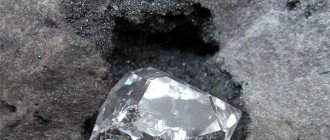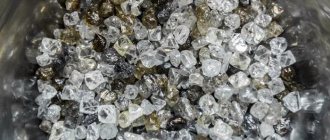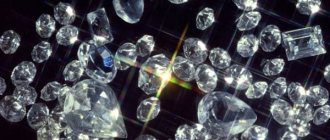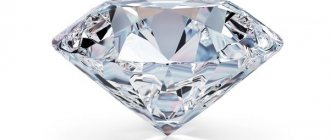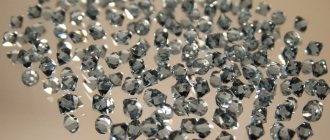Contrary to popular misconceptions, diamonds in nature are not found throughout the entire surface of the earth’s crust. Carbon, a non-metal that is the basis of this mineral, becomes a diamond only when exposed to extremely high temperatures and pressure at a depth of 160 to 480 km . The “cradle” of the overwhelming majority of crystals are volcanoes; it is thanks to them that diamonds are closer to the surface, so quarrying is carried out in areas with increased volcanic activity. Some minerals are simply washed out of the kimberlite pipes.
How are they formed?
It was not possible to establish the exact version of the origin of gems, but the period of their origin was quite accurately determined - from 100 million to 2.5 billion years ago. Diamond is obtained from carbon under high temperature and pressure, so the depth of the deposits reaches at least 200 kilometers. Scientists have been studying this issue for a long time and have put forward several theories:
The first version is the idea of diamonds appearing on the surface of the earth. According to it, the mineral was the result of contact between erupted frozen magma and hydrocarbons. This led to the formation of a high-density crystal lattice.
Most scientists are inclined to believe that the origin of diamonds is associated with ultramafic rock. When a volcano erupts, the lava that comes out throws stones to the surface - these are diamonds in their natural form.
The earth's crust contains a lot of diamonds, but industrial mining can be carried out in a limited number of deposits. One of the popular places to search for precious stones is volcanoes after an eruption, where there is a high chance of finding a valuable mineral. However, the extraction process must be carefully prepared; this requires specialized equipment.
Mantle-magmatic theory
Proponents of the mantle-magmatic theory believe that diamonds originate from coal seams, which for a long time were in a chemically homogeneous environment under a pressure of more than 5000 Pa. As a result of the breakthrough of magma to the surface from a depth of 150 km, diamonds are carried from the chambers to the surface.
There are 3 groups of magmatic theories:
- Diamonds form in the upper layers of the earth's crust when hydrocarbons from the host rocks enter solidifying magma.
- Diamonds form in ultramafic rocks. Molten magma disintegrates the diamond formation, releases individual units and carries it upward with the magma flow.
- Diamonds are mainly formed in the depths of ultramafic magma, as well as during its release to the surface.
The third version is currently recognized as the most realistic. The concentration of diamonds in the bowels of the earth is quite high; it is not a rare mineral. Another thing is that only a few of the deposits are accessible to humans for industrial production.
Where do diamonds come from in meteorites?
The hypothesis about the meteorite origin of the mineral caused heated discussions, because diamonds were found in some specimens. Today, the overwhelming majority of scientists are inclined to believe that diamonds in meteorites arose as a result of impacts in the asteroid belt. When falling to the ground, a new rock was formed on the surface of the latter - impactites, the conditions for the formation of which correspond to those of diamonds. The particles involved in the impact contain carbon, which under the influence of pressure of 40-50 GPa and temperature of 2-3 thousand degrees Celsius can become diamond.
Impact deposits are a common phenomenon and originated several million years ago. One of the most famous is the Popigai astroproblem, whose diameter reaches 100 km. It is located on the border of modern Krasnoyarsk and Yakutia; the meteorite that fell there had a radius of 3.5 km. At the same time, the extraction of meteorite diamonds is not feasible for industry - they are too small.
Origin of diamonds
Diamond is a mineral, a crystalline modification of pure carbon. Diamonds are characterized by crystallization in the form of octahedrons, less often in the form of a cube. For diamond formation, it is important that the temperature increase as the pressure decreases. These stones are distinguished by their individual uniqueness; it is impossible to find two identical stones - it’s like fingerprints.
Diamonds tend to originate in continental regions with geological stability. In order for carbon to change the form of graphite to a more rigid structure, it must lie at a depth of 100-200 km under the influence of a temperature of 1100 - 1300 ° C.
How is mining done?
Mining diamonds from scratch is a complex and labor-intensive process that includes several stages. First you need to find a deposit and start developing it, and not every deposit contains diamonds suitable for mining. After completing the preliminary work, the extraction of ore begins. It is mined using machinery and then crushed. In this state, it becomes possible to extract kimberlite rock from it, which is the goal of primary processing.
The kimberlite is then sent to production, where it is sorted according to several parameters to accurately determine its class and size. An important criterion is the suitability of the stone for jewelry work or various devices. Despite the distribution of kimberlite ore almost throughout the globe, its reserves are greatest in Russia, Canada and Botswana. The first attempts to mine diamonds were made back in the 17th century and were very successful.
PROPERTIES
Diamond in the Rough
Diamond can be colorless, water-transparent or colored in various shades of yellow, brown, red, blue, green, black, gray. The color distribution is often uneven, patchy or zonal. Under the influence of X-rays, cathode and ultraviolet rays, most diamonds begin to glow (luminesce) in blue, green, pink and other colors. Characterized by exceptionally high light refraction. The refractive index (from 2.417 to 2.421) and strong dispersion (0.0574) determine the bright shine and multi-colored “play” of cut jewelry diamonds, called brilliants. The shine is strong, from diamond to greasy. Density 3.5 g/cm3. On the Mohs scale, the relative hardness of diamond is 10, and the absolute hardness is 1000 times higher than the hardness of quartz and 150 times that of corundum. It is the highest among all natural and artificial materials. At the same time, it is quite fragile and breaks easily. The fracture is conchoidal. Does not interact with acids and alkalis in the absence of oxidizing agents. In air, diamond burns at 850° C with the formation of CO2; in a vacuum at temperatures above 1,500 ° C it turns into graphite.
Place of Birth
Diamond deposits are of two types: primary in the form of kimberlite and lamproite pipes and placers. The latter are secondary deposits; they are formed during the destruction of primary deposits. In the vast majority of cases, mining occurs in tubes. Lamproite pipes are a type of igneous rock; large deposits of them were found in Australia at the end of the 20th century. However, the find did not bring much wealth - the diamonds turned out to be so tiny that it was impossible to use them for jewelry. Their use is 90-95% aimed at industrial purposes. A unique deposit is Argyle, where the rarest pink diamonds were discovered.
Kimberlite pipes are common in Russia, Canada and Africa - in the latter they were found first. It was there that an 85-carat diamond was found in the 19th century, causing a sensation among gem seekers. The diamond fever led to the discovery of a stone weighing 428.5 carats a few years later - it was named “De Beers”. The only place where there are no diamond deposits is Antarctica, which is logical, given the specifics of their formation.
DIAMOND DE BEERS
Diamonds of earthly origin
A distinctive feature of all diamond mining quarries is their location in areas with high volcanic activity. Kimberlite pipes are vents left over from volcanoes destroyed by erosion.
It is noteworthy that diamonds of terrestrial origin have a cubic crystal lattice, while diamonds from meteorites have a hexagonal lattice. During the formation process, a diamond crystal absorbs inclusions of melts, fluids and minerals from the external environment. The shade of the mineral depends on the specific embedding of nitrogen atoms into the crystal lattice.
- “C-centers” refer to individual atomic centers;
- If a pair of nitrogen atoms unite under the influence of diffusion, “A-” is formed - these are several “A-centers” united in the plane.
If “C-centers” predominate, the diamond is yellow, “A- and B-centers”, when predominant, form the transparency of the stone.
How to distinguish from quartz?
Among the minerals there are many similar in appearance, which scammers take advantage of. They pass off a cheap analogue as a rare and expensive stone - for example, quartz instead of diamond. With a cursory examination, only a jeweler will be able to distinguish a fake, but the buyer needs to know several basic differences between them.
- It is easiest to check a completely transparent stone. To do this, you need to lower it into a glass of clean water and carefully examine it. After such a procedure, quartz will be “lost”, becoming invisible. The diamond will retain its outline. This verification method is not suitable for color copies.
- Diamond is one of the hardest minerals; quartz cannot compare to it in this regard. Therefore, if you apply strong pressure to the last stone, it will certainly become deformed. It is enough to squeeze the stone being tested between two coins and move them to the sides. There will not be a scratch on a real diamond.
- Steam on the surface of a diamond does not condense; just breathe on it to be convinced of this. If droplets appear on it, it is quartz. This simple method is convenient for determining authenticity in jewelry stores.
- It is impossible to read text through a diamond; it strongly refracts light. But through quartz the letters look correct and undistorted.
The latter method is unlikely to be performed in a jewelry store, but it can be done at home. To do this, you need to drop quite a bit of water onto one face of the proposed diamond. Then run a thin needle along its surface - if the drop spreads, it is quartz.
Synthetic minerals
People have long dreamed of learning how to create this non-metal on their own, but this only happened in the 20th century. Carbon, or more precisely its source - graphite, is subjected to extreme pressure and high temperature. This occurs using a hydraulic press and electric current. Forming diamonds this way is reliable, but expensive.
There are two more methods by which artificial “kings of stones” appear: by exposure to an explosion and by growing crystals in a methane environment. Artificial minerals are more often used in production than in jewelry, although they are in no way inferior to natural ones.
The basis of production, carbon, is a very common material, so there are no problems with the extraction of raw materials for the artificial creation of stones. In terms of price, quality and availability, the best raw material is graphite, which is why it is used most often.
How to distinguish from a fake?
Diamonds are identical in appearance to many minerals, while being the rarest and most expensive. Among the stones most often used for making counterfeits are:
- Rhinestone;
- White zirconium;
- Quartz;
- Topaz.
Synthetic materials (cubic zirconia, for example) are easy to distinguish from the original by their cut and shine - they are more like zirconium. Their transparency and hardness are several orders of magnitude lower.
The main difference between diamond and other stones is its high hardness. It can cut glass and withstand sandpaper or a knife blade without scratching. Even with a strong blow, it will not break - not a single fake will survive such tests.
There is an opinion that a diamond can be easily distinguished by the fact that it heats up slowly in the hand - low heat capacity. But many semi-precious stones have the same property, so the method is applicable only to synthetic fakes.
Diamond does not attract dust and will not dissolve even in hydrochloric acid. It is difficult to discern the text through it; in the water it does not lose its outline. The shine of a diamond is grayish, with a white sheen. It is a misconception to believe that it shimmers with the colors of the rainbow.
Giant space ball
The question of where diamonds come from has been studied from different angles. When the study of these stones of meteorite origin began, some scientists believed that in space the mineral breaks off from huge diamond planets and, connecting with a meteorite, flies to Earth.
This theory was not confirmed: the crystals were formed exactly as described above. However, in outer space there really is at least one body partially consisting of a valuable stone. The white dwarf star Lucy, located in the constellation Centaur, has a core of pure diamond. Its weight is difficult to calculate accurately: scientists talk about trillions of trillions of carats, and the diameter of the spherical core is about 4 thousand kilometers.
Kimberlite pipe "Mir"
In Yakutia, near the city of Mirny, there is the largest diamond quarry in the world - the Mir kimberlite pipe. This diamond pipe was discovered by Soviet geologists in 1955. And a year earlier - in 1954 - the first “diamond tube” in Yakutia was found, which was called “Zarnitsa”. Despite the fact that it was discovered earlier, it was Mir that began to be developed first.
The history of the discovery of the Mir kimberlite pipe is unusual in its own way. Soviet geologist Natalya Vladimirovna Kind compiled a forecast map and indicated the approximate area where the “diamond pipe” should be located. An expedition headed by three experienced geologists: Yuri Ivanovich Khabardin, Ekaterina Nikolaevna Elagina and Vladimir Petrovich Avdeenko set off in search of her. When geologists were convinced that the forecast map correctly pointed to the kimberlite pipe, determined its boundaries and took samples of kimberlite, they sent an encrypted telegram to management.
We smoked a peace pipe, the tobacco was excellent. Avdeenko, Elagina, Khabardin.
radiogram about the discovery of the Mir diamond pipe on June 13, 1955
Just two years after the discovery of the Mir kimberlite pipe, open-pit diamond mining began. Only 44 years later, when the surface possibilities were completely exhausted, in 2001, diamond miners switched to the underground method. Over these four decades, the Mir quarry has become the largest in the world: its depth is 525 meters, its diameter is 1.2 kilometers. But due to an accident on August 4, 2017, when a water breakthrough occurred at the mine, the quarry was flooded and it is unknown when work will continue.
But it is known for sure that over the years of development of the quarry, diamonds worth 17 billion US dollars were mined. The largest diamond from the Mir kimberlite pipe was found on December 23, 1980. Its weight is 342.5 carats. Diamond was given the Soviet name “XXVI Congress of the CPSU”.
OPTICAL PROPERTIES
| Type | isotropic |
| Refractive indices | nα = 2.418 |
| Maximum birefringence | δ = 2.418 - isotropic, does not have birefringence |
| Optical relief | moderate |
| Optical axis dispersion | strong |
| Pleochroism | does not pleochroate |
| Luminescence in ultraviolet radiation | sometimes blue or phosphorescent |
Kimberlite pipe as a geological formation
A kimberlite pipe can be compared to a giant chimney or well. Externally, “diamond tubes” resemble a funnel: they are wider towards the surface of the earth and narrow, going deeper. In fact, it is a kind of ancient volcano, the ground part of which is completely destroyed due to erosion processes. Therefore, detecting the handset is not easy.
Despite the fact that scientists have been studying kimberlite pipes for many decades, the number of mysteries does not decrease every year. On the contrary: the more we know about them, the more “diamond tubes” surprise scientists.
Here are just two riddles. First, why are kimberlite pipes located on the most ancient and stable platforms? It is known that the earth's crust is not homogeneous. The ocean floor, volcanic plateaus - in these places the earth's thickness is much less, but “diamond pipes” are found on the most stable earth blocks. This does not at all correspond to ordinary logic and the popular wisdom known to us - “where it is thin, it breaks.” The second mystery is the shape of the kimberlite pipe, reminiscent of a martini glass - a cone on a thin stem.
Diamond in the Rough
The contents of the “diamond pipe” - kimberlite - is a rock consisting of olivine, phlogopite, pyrope and other minerals, including natural diamonds. But diamonds are distributed unevenly in a kimberlite pipe. They can be compared to the arrangement of raisins in a bun: somewhere more, somewhere less, somewhere not at all.
The uneven distribution of diamonds in kimberlite diatremes significantly complicates the planned development of primary deposits. Identifying the features of vertical variability of kimberlite rocks to the depth of their profitable mining is one of the most important tasks. Despite the study of the diatremes of the Siberian Platform, the issues of their diamond potential are debatable.
Journal "Domestic Geology" 2021, article by N.N. Zinchuk “Features of diamond potential of different phases of kimberlite intrusion”
PHYSICAL PROPERTIES
| Mineral color | colorless, yellowish-brown fading to yellow, brown, black, blue, green or red, pink, cognac brown, blue, lilac (very rare) |
| Stroke color | no |
| Transparency | transparent, translucent, opaque |
| Shine | diamond, bold |
| Cleavage | octahedron perfect |
| Hardness (Mohs scale) | 10 |
| Kink | uneven |
| Strength | fragile |
| Density (measured) | 3.5 – 3.53 g/cm3 |
| Radioactivity (GRapi) | 0 |
| Thermal properties | High thermal conductivity. It feels cold to the touch, which is why diamonds are called “ice” in slang. |
